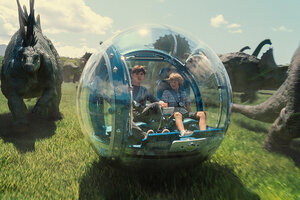Jurassic World: Top 5 inaccuracies in movie, according to paleontologists
'Jurassic World' was this weekend's big box office winner. But is the science accurate?

Nick Robinson and Ty Simpkins in a scene from "Jurassic World," released yesterday in theaters.
ILM/Universal Pictures/Amblin Entertainment via AP
The numbers are in, and to little surprise, the much-anticipated release of cult favorite “Jurassic World” has blown away the box office this weekend, grossing a staggering $82.3 million, according to reports.
But as critics buzz over the film’s potential bank as the biggest movie box office opening of all time, some dinosaur fans are conferring about the credibility of the science in the movie – and the possible confusion over blending fact and fiction.
“I feel like paleontologists fear they may get a lot of dumb questions because of the dinosaurs in this film,” fossil enthusiast Brian Switek told the New York Times.
“Part of the reason the director Colin Trevorrow’s dinosaurs have such potential to confuse is because not everything about them is scientifically far-fetched,” the report continued.
For years, “Jurassic Park” creators have trumpeted the amount of careful research that has poured into creating some of their dinosaurs’ features. In its latest film, for instance, the interior “palatal” teeth of a mosasaur impressed many experts. "That really shows an attention to detail,” a paleontologist told National Geographic.
So what mistakes were made in “Jurassic World?”
-
Most dinosaurs should have feathers – all different kinds.
The dinosaur community’s No. 1 complaint is that the film’s research appears to be outdated, relying on hypotheses made in the 1980s rather than scientists’ recent discoveries. We now know, for example, that the majority of dinosaurs had a variety of plumage, “from insulating tufts to decorative barbs to fully developed feathers,” reported National Geographic. The movie’s feather-free velociraptors appear to show otherwise. -
The velociraptors are too big.
Real velociraptors were roughly the same size as a “medium-sized dog” weighing 75 pounds, according to the University of California Museum of Paleontology. -
Similarly, the mosasaurs are also too big, and should not have a frill on their backs.
Scientists disproved the existence of a frill about 10 years ago, and expressed amazement at how “supersize” the mosasaurs appeared.
-
Pterosaurs can't lift people into the air.
The ones in “Jurassic World” managed to, but real pterosaurs would not have had half the strength required, according to paleontologists. -
The velociraptors’ wrists shouldn’t be able to move so much.
Experts said the velociraptors’ hands were shown in a posture the paleontology community has since departed from. Their wrists should instead have been pointed inward, “as if they were holding a basketball,” reported the New York Times.
Why then, do paleontologists continue to express their fondness for the Jurassic Park movie series in the face of such striking inaccuracies? "If you're a young paleontologist, and you have a job, the movies have some part in that, frankly," Smithsonian paleontologist Matthew Carrano told the Washington Post.

